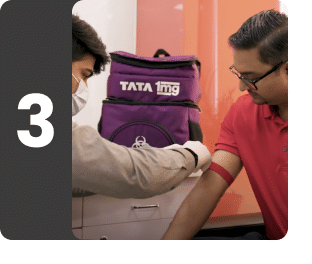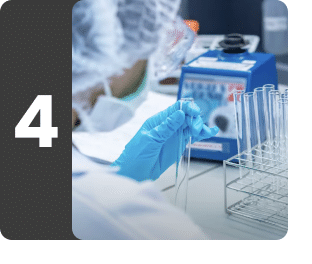Energy Screening Package in New Delhi
Understanding Energy Screening Package in New Delhi
What is Energy Screening Package in New Delhi?
Low energy may lead to unexpected tiredness, lethargy, or dullness. Diseases or deficiencies such as anemia, vitamin D deficiency, electrolyte imbalances, diabetes, some infections, or vitamin B12 deficiency are among many other factors that may contribute to this.
This package consists of tests to help identify the root cause of your low energy. These include Vitamin B12, Vitamin D, serum electrolytes, basic iron studies, complete blood count (CBC), and glucose-fasting (FBS), all or some of which may be contributing to your low energy levels.
What does Energy Screening Package measure?
Contains 31 tests
Serum Iron Studies Basic
A Serum Iron Studies Basic test measures the level of iron in the body. It comprises a series of blood tests, including a serum iron test that measures the level of iron in the blood, a Total Iron-Binding Capacity (TIBC) test that reflects the body's iron stores, an unsaturated iron binding capacity (UIBC) test that reflects binding of iron with transferrin which is the main protein that binds with iron, and transferrin saturation test that checks how much transferrin is saturated with iron.
Know more about Serum Iron Studies Basic
Total Iron Binding Capacity
A Total Iron Binding Capacity test measures the ability of your blood to bind and transport iron, and therefore reflects your body's iron stores. TIBC correlates with the amount of transferrin, a protein, in your blood, that helps bind iron and facilitates its transportation in the blood. Usually, about one-third of the transferrin measured is being used to transport iron, and this is called transferrin saturation.
Iron Serum
An Iron Serum test determines iron levels in the blood and can help diagnose conditions like anemia, or iron overload in the body. People usually suffer from low iron levels in the blood if they prefer a diet that has low iron content, or if their body has trouble absorbing the iron from the foods or supplements they intake. Low iron levels can also occur due to intense blood loss or even during pregnancy. Similarly, an excess amount of iron in the blood can occur due to over-intake of iron supplements, blood transfusions, or if you are suffering from a condition called hemochromatosis (a rare genetic disorder that causes too much iron to build up in the body or cause problems in the body to remove excess iron).
Therefore, doctors often suggest an Iron Serum to help check the status of your iron level, get valuable information about your nutritional well-being, detect potential health issues (if any), and take timely preventive measures.
Unsaturated Iron Binding Capacity
An Unsaturated Iron Binding Capacity test determines the reserve capacity of transferrin, i.e., the portion not yet saturated with iron. The iron-binding capacity of our body can be segregated into two parts – Total Iron Binding Capacity (TIBC) and Unsaturated Iron Binding Capacity (UIBC). UIBC refers to the capacity of transferrin, a protein that transports iron, to bind with additional iron. In easy terms, it represents the available "slots" on transferrin to carry iron molecules. Unlike iron saturation, which assesses the occupied slots, UIBC measures the unoccupied ones.
Transferrin Saturation
A Transferrin Saturation test determines an individual’s iron status by using the ratio of serum iron concentration and total iron binding capacity (TIBC) as a percentage. The test tells us how much iron in the blood is bound to transferrin, the main protein in the blood that binds to iron and transports it throughout the body. Under normal conditions, transferrin is one-third saturated with iron, so about two-thirds of its capacity is held in reserve. This test is often employed alongside others to evaluate iron levels and diagnose conditions like iron deficiency anemia, if transferrin saturation is low, or hemochromatosis (an iron overload disorder), if transferrin saturation is on the higher side than normal.

Serum Electrolytes
A Serum Electrolytes test measures three important electrolytes in the body: sodium, potassium, and chloride. Electrolytes are electrically charged minerals that move fluid in and out of the cells. They transport the nutrients into the cells and flush out the waste products. They also help maintain water balance and pH levels by keeping the acids and bases in your blood balanced. Hence, the body must maintain an optimal balance of fluids and electrolytes for proper functioning.
Know more about Serum Electrolytes
Potassium
A Potassium test measures the levels of potassium in your body. Potassium is one of the key electrolytes that helps in the functioning of the kidneys, heart, nerves, and muscles. It also balances the effect of sodium and helps keep your blood pressure normal. The body absorbs the required amount of potassium from the dietary sources and eliminates the remaining quantity through urine. Potassium level is typically maintained by the hormone aldosterone. Aldosterone acts on the nephrons present in the kidneys and activates the sodium-potassium pump that helps the body reabsorb sodium and excrete potassium. This aids in maintaining a regular and steady potassium level in the blood.
Chloride
A Chloride test measures the amount of chloride in your body. Chloride is present in all body fluids and is found in the highest concentration in the blood and extracellular fluid (fluid present outside the cells). The body gets most of the chloride through dietary salt (sodium chloride or NaCl) and a small amount through other food items. The required amount of chloride is absorbed in the body and the excess amount is excreted by the kidneys through urine. When the chloride is combined with sodium it is mostly found in nature as salt. Chloride generally increases or decreases in direct relationship to sodium but may also change without any changes in sodium levels when there are problems with the body's pH. Usually, the normal blood chloride level remains steady with a slight fall after meals (because the stomach produces hydrochloric acid using chloride from the blood after we eat food).
Sodium
-
By producing hormones that control the elimination of sodium through urine, such as natriuretic peptides and aldosterone.
-
By producing hormones that prevent water loss, such as antidiuretic hormone (ADH) or vasopressin.
-
By controlling thirst (an increase in blood sodium level can make you thirsty and cause you to drink water, returning your sodium to normal).
A Sodium test is used to measure the amount of sodium in your body. Sodium is present in all body fluids and is found in the highest concentration in the extracellular fluid. The body absorbs the required amount of sodium through dietary salts and the remaining is eliminated through the kidneys. The body keeps your blood sodium within a normal and steady range by following three mechanisms:
These mechanisms regulate the amount of water and sodium in the body and control blood pressure by keeping the amount of water in check. When the level of sodium in the blood changes, the water content in your body changes. These changes can be associated with dehydration, edema, and change in blood pressure.

Vitamin D (25-Hydroxy)
A Vitamin D (25-Hydroxy) test measures the levels of vitamin D in the body. It is an essential nutrient that can be synthesized in the body upon healthy exposure to sunlight or absorbed from dietary sources. It majorly exists in two forms: Vitamin D2 (ergocalciferol) and Vitamin D3 (cholecalciferol). Vitamin D2 is present in plants, such as yeast or mushrooms, and is available as a supplement in fortified foods, and vitamin D3 is found in foods like cheese, green vegetables, mushrooms, egg yolks, and fatty fish.
Both forms of vitamin D (D2 and D3) need to undergo some chemical changes before being available for use in the body. These chemical changes take place in the liver or kidneys. The liver converts vitamin D to 25-hydroxyvitamin D (25-OH vitamin D). A Vitamin D (25-Hydroxy) test measures the level of this 25-OH vitamin D as it is the primary form of vitamin D that circulates in the blood.
Know more about Vitamin D (25-Hydroxy)

CBC (Complete Blood Count)
A CBC (Complete Blood Count) test evaluates red blood cells (RBCs), white blood cells (WBCs}, and platelets. Each of these blood cells performs essential functions–RBCs carry oxygen from your lungs to the various body parts, WBCs help fight infections and other diseases, and platelets help your blood to clot–so determining their levels can provide significant health information. A CBC test also determines the hemoglobin level, a protein in RBC that carries oxygen from the lungs to the rest of your body. Evaluating all these components together can provide important information about your overall health.
Know more about CBC (Complete Blood Count)
Absolute Lymphocyte Count
-
T lymphocytes (T cells): T cells control your body’s immune system response and directly attack and kill infected cells and tumor cells.
-
B lymphocytes (B cells): B cells make antibodies. Antibodies are proteins that target viruses, bacteria, and other foreign pathogens.
An Absolute Lymphocyte Count test measures the total number of lymphocytes in the blood. Lymphocytes are a type of white blood cells that play an important role in your immune system and help your body fight disease and infection. There are two main types of lymphocytes:
Lymphocytes help your immune system remember every antigen (a foreign substance) it comes in contact with. After an encounter, some lymphocytes turn into memory cells. When these memory cells run into an antigen again, they recognize it and quickly respond. It is also the reason why getting vaccinated helps prevent certain diseases.
Absolute Neutrophil Count
An Absolute Neutrophil Count test measures the percentage of neutrophils per microliter of blood. Neutrophils are a type of WBC and play an integral part in the body's immune system. They help fight off bacterial infections in the body by identifying and destroying foreign invaders, such as disease-causing microorganisms.
Differential Leukocyte Count
- Differential Neutrophil Count
- Differential Lymphocyte Count
- Differential Monocyte Count
- Differential Eosinophil Count
- Differential Basophil Count
There are five types of WBCs: neutrophils, lymphocytes, monocytes, eosinophils, and basophils. A Differential Leukocyte Count test measures the percentage of each type of WBC in the blood. Leukocytes or WBCs are produced in the bone marrow and defend the body against infections and diseases. Each type of WBC plays a unique role to protect against infections and is present in different numbers.
This further contains
Red Blood Cell Count
A Red Blood Cell Count test measures the total number of red blood cells in your blood. RBCs are the most abundant cells in the blood with an average lifespan of 120 days. These cells are produced in the bone marrow and destroyed in the spleen or liver. Their primary function is to help carry oxygen from the lungs to different body parts. The normal range of RBC count can vary depending on age, gender, and the equipment and methods used for testing.
Hb (Hemoglobin)
An Hb (Hemoglobin) test measures the concentration of hemoglobin protein in your blood. Hemoglobin is made up of iron and globulin proteins. It is an essential part of RBCs and is critical for oxygen transfer from the lungs to all body tissues. Most blood cells, including RBCs, are produced regularly in your bone marrow. The Hb test is a fundamental part of a complete blood count (CBC) and is used to monitor blood health, diagnose various blood disorders, and assess your response to treatments if needed.
Platelet Count
A Platelet Count test measures the average number of platelets in the blood. Platelets are disk-shaped tiny cells originating from large cells known as megakaryocytes, which are found in the bone marrow. After the platelets are formed, they are released into the blood circulation. Their average life span is 7-10 days.
Platelets help stop the bleeding, whenever there is an injury or trauma to a tissue or blood vessel, by adhering and accumulating at the injury site and releasing chemical compounds that stimulate the gathering of more platelets. A loose platelet plug is formed at the site of injury and this process is known as primary hemostasis. These activated platelets support the coagulation pathway that involves a series of steps, including the sequential activation of clotting factors; this process is known as secondary hemostasis. After this step, there is a formation of fibrin strands that form a mesh incorporated into and around the platelet plug. This mesh strengthens and stabilizes the blood clot so that it remains in place until the injury heals. After healing, other factors come into play and break the clot down so that it gets removed. In case the platelets are not sufficient in number or not functioning properly, a stable clot might not form. These unstable clots can result in an increased risk of excessive bleeding.
Total Leukocyte Count
A Total Leukocyte Count test measures the numbers of all types of leukocytes, namely neutrophil, lymphocyte, monocyte, eosinophil, and basophil, in your blood. Leukocytes or WBCs are an essential part of our immune system. These cells are produced in the bone marrow and defend the body against infections and diseases. Each type of WBC plays a unique role to protect against infections and is present in different numbers.
Absolute Basophil Count
An Absolute Basophil Count test measures the total number of basophils in the blood. Basophils are small, spherically-shaped cells that originate from bone marrow and make up almost 1% of the total white blood cells in the body. They attack a foreign substance and release proteins like histamine and heparin to destroy harmful substances, such as allergens, pathogens, or parasites. Histamine helps widen the blood vessels and make space for more immune cells to come to the site of infection or injury, whereas heparin acts as a blood-thinning agent and helps to avoid blood clotting at that site.
Absolute Monocyte Count
An Absolute Monocyte Count test measures the total number of monocytes in the blood. Monocytes are a type of WBC that originate from bone marrow and travel to different tissues via the blood. Once they are inside the tissue, these cells get converted to macrophages (a type of cell that digest harmful substances). Monocytes are the second line of defense mechanism of the human body after neutrophils. These cells are also responsible for the removal of injured or dead cells, microorganisms, and other insoluble particles from the blood.
Absolute Eosinophil Count
An Absolute Eosinophil Count test measures the number of eosinophils in the blood and provides important information about the functioning of the immune system. Eosinophils originate from bone marrow and have a lifespan of 8-18 hours. These cells are involved in fighting certain types of infections and responding to allergic reactions in the body. Other functions of these cells include movement to the inflammation areas, trapping substances, killing cells, and bactericidal and antiparasitic activities. They also help in the treatment of immediate allergic reactions and modulation of inflammatory responses. By measuring the number of eosinophils in the blood, this test provides important information about the functioning of the immune system.
Hematocrit
A Hematocrit test measures the proportion of red blood cells (RBCs) in your blood as a percentage of the total blood volume. It is a crucial part of a complete blood count (CBC) and helps in assessing your blood health. RBCs are responsible for carrying oxygen from the lungs to different parts of the body. The hematocrit test provides valuable information about your blood's oxygen-carrying capacity.
Higher-than-normal amounts of RBCs produced by the bone marrow can cause the hematocrit to increase, leading to increased blood density and slow blood flow. On the other hand, lower-than-normal hematocrit can be caused by low production of RBCs, reduced lifespan of RBCs in circulation, or excessive bleeding, leading to a reduced amount of oxygen being transported by RBCs. Monitoring your hematocrit levels is essential for diagnosing and managing various blood-related disorders.
Mean Corpuscular Volume
A Mean Corpuscular Volume test measures the average size of your red blood cells, which carry oxygen through your body. This test tells whether your RBCs are of average size and volume or whether they are bigger or smaller.
Mean Corpuscular Hemoglobin
An MCH test measures the average amount of hemoglobin in a single red blood cell (RBC). Hemoglobin is an iron-containing protein in RBCs, and its major function is to transport oxygen from the lungs to all body parts. This test provides information about how much oxygen is being delivered to the body by a certain number of RBCs.
Mean Corpuscular Hemoglobin Concentration
An MCHC test measures the average amount of hemoglobin in a given volume of RBCs. MCHC is calculated by dividing the amount of hemoglobin by hematocrit (volume of blood made up of RBCs) and then multiplying it by 100.
Mean Platelet Volume
An MPV test measures the average size of the platelets in your blood. Platelets are disk-shaped tiny cells originating from large cells known as megakaryocytes, which are found in the bone marrow. After the platelets are formed, they are released into the blood circulation. Their average life span is 7-10 days.
Platelets help stop bleeding whenever there is an injury or trauma to a tissue or blood vessel by adhering and accumulating at the injury site, and by releasing chemical compounds that stimulate the gathering of more platelets. After these steps, a loose platelet plug is formed at the site of injury, and this process is known as primary hemostasis. These activated platelets support the coagulation pathway that involves a series of steps including the sequential activation of clotting factors; this process is known as secondary hemostasis. After this, there is a formation of fibrin strands that form a mesh incorporated into and around the platelet plug. This mesh strengthens and stabilizes the blood clot so that it remains in place until the injury heals. After healing, other factors come into play and break the clot down so that it gets removed. In case the platelets are not sufficient in number or are not functioning properly, a stable clot might not form. These unstable clots can result in an increased risk of excessive bleeding.
PDW
A PDW test reflects variability in platelet size, and is considered a marker of platelet function and activation (clot formation in case of an injury). This marker can give you additional information about your platelets and the cause of a high or low platelet count. Larger platelets are usually younger platelets that have been recently released from the bone marrow, while smaller platelets may be older and have been in circulation for a few days. Higher PDW values reflect a larger range of platelet size, which may result from increased activation, destruction and consumption of platelets.
RDW CV
An RDW CV test which is part of red cell indices, helps identify characteristics of red blood cells. RDW (red cell distribution width) measures the variations in the sizes of red blood cells, indicating how much they differ from each other in a blood sample. RDW is expressed as RDW-CV, a coefficient of variation. A higher RDW may suggest more variation in red cell sizes, while a lower RDW indicates more uniform red cell sizes.

FBS (Fasting Blood Sugar)
A fasting blood sugar test measures the glucose level in the body under overnight fasting conditions. Glucose serves as the body's energy currency and is broken down through metabolism to produce energy. Hormones and enzymes produced by the liver and pancreas control this process. The hormone insulin, produced by the pancreas, regulates blood glucose levels. When these levels are high, such as after a meal, insulin is secreted to transport glucose into cells for energy production. Elevated glucose levels in the body after fasting may indicate a risk of developing prediabetes or diabetes, which can be of two types- Type 1, caused by little or no insulin production, and Type 2, caused by insulin resistance or decreased insulin production.
Know more about FBS (Fasting Blood Sugar)

Vitamin B12
A Vitamin B12 test measures your vitamin B12 levels. Vitamin B12 is essential for various health aspects, such as maintaining a healthy nervous system, making red blood cells, and creating the genetic material of our cells. Low vitamin B12 levels are more likely to occur in older adults, children, vegans, vegetarians, people with diabetes, individuals who underwent gastric bypass surgery, women who are breastfeeding, and in conditions that impact absorption of this vitamin, like Crohn’s disease. Higher vitamin B12 levels seen in pateint on vitamin suplement does not need treatment as excessive vitamin B12 is usually removed through the urine. However, some conditions, such as liver diseases and myeloproliferative disorders, can cause an increase in vitamin B12 levels, thereby affecting blood cell production.
Know more about Vitamin B12
Book Energy Screening Package at-home





Other tests









